Add this eBook to your basket to receive access to all 214 records. Our indexes include entries for the spelling brodrick. In the period you have requested, we have the following 214 records (displaying 31 to 40): These sample scans are from the original record. You will get scans of the full pages or articles where the surname you searched for has been found. Your web browser may prevent the sample windows from opening; in this case please change your browser settings to allow pop-up windows from this site. Treasury Books
(1711)
Records of the Treasury administration in Britain, America and the colonies, for 1711. These also include records of the appointment and replacement of customs officers such as tide waiters and surveyors. | Sample scan, click to enlarge

| Treasury Books
(1717)
Records of the Treasury administration in Britain, America and the colonies, for 1717. These also include records of the appointment and replacement of customs officers such as tide waiters and surveyors. | Sample scan, click to enlarge

| Letters from Oxford
(1710-1729)
Letters from Dr William Stratford of Christ Church, Oxford, to Edward Harley: full of political and personal gossip. | Sample scan, click to enlarge
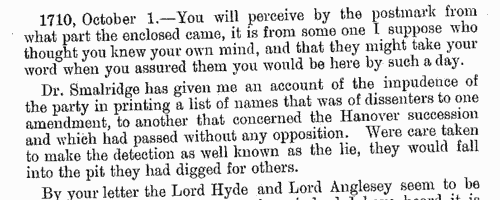
| Wandsworth Burials
(1730)
The ancient parish of Wandsworth in Surrey comprised the single township of Wandsworth, including the hamlets of Garratt, Half Farthing and Summers Town. It lay in the archdeaconry of Surrey of the diocese of Winchester: unfortunately, few bishop's transcripts of Surrey parish registers survive earlier than 1800. Although the original parish registers of Wandsworth doubtless commenced in 1538, the volume(s) before 1603 had been lost by the 19th century. In 1889 a careful transcript by John Traviss Squire of the first three surviving registers was printed, and we have now indexed it year by year. The early burial registers contain little detail - date of burial, and full name. For the burial of children, the father's name is also stated; for the burial of wives, the husband's. Such details as date or cause of death, age, address or occupation are almost never given. The burial registers are considerably more bulky than the baptism registers, because the burying ground was used by Dissenters, who formed a large part of the population. These include a French Protestant congregation that worshipped in a church (the registers of which do not survive) in a courtyard immediately opposite the parish church. The Quakers had a cemetery of their own. The 18th-century burial registers also include a surprising number of children sent out to Wandsworth from London to nurse. | Sample scan, click to enlarge
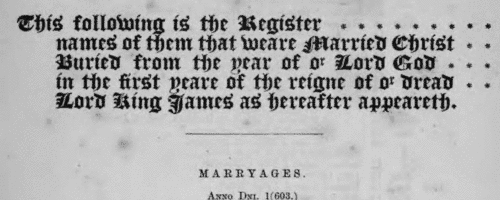
| Wandsworth Burials
(1731)
The ancient parish of Wandsworth in Surrey comprised the single township of Wandsworth, including the hamlets of Garratt, Half Farthing and Summers Town. It lay in the archdeaconry of Surrey of the diocese of Winchester: unfortunately, few bishop's transcripts of Surrey parish registers survive earlier than 1800. Although the original parish registers of Wandsworth doubtless commenced in 1538, the volume(s) before 1603 had been lost by the 19th century. In 1889 a careful transcript by John Traviss Squire of the first three surviving registers was printed, and we have now indexed it year by year. The early burial registers contain little detail - date of burial, and full name. For the burial of children, the father's name is also stated; for the burial of wives, the husband's. Such details as date or cause of death, age, address or occupation are almost never given. The burial registers are considerably more bulky than the baptism registers, because the burying ground was used by Dissenters, who formed a large part of the population. These include a French Protestant congregation that worshipped in a church (the registers of which do not survive) in a courtyard immediately opposite the parish church. The Quakers had a cemetery of their own. The 18th-century burial registers also include a surprising number of children sent out to Wandsworth from London to nurse. | Sample scan, click to enlarge
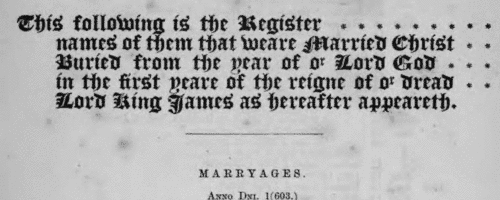
| Inhabitants of Hertfordshire
(1702-1732)
These people signed various rolls at Hertford, mainly concerning allegiance. The letters are the key to the rolls involved:
a. Oaths of allegiance, supremacy and abjuration under an Act of 1 George I: 1727 to 1732;
b. Oaths of allegiance, supremacy and abjuration under an Act of 6 Anne: 25 April 1715;
c. Oaths of allegiance, supremacy and abjuration under an Act of 6 Anne: 21 August 1714 to 21 April 1718;
d. Oath for naturalizing Foreign Protestants under Act of 7 Anne: 10 May to 15 August 1719;
e. Oath of allegiance under Act of 1 Anne: I. 13 July 1702 to 19 July 1714; II. 13 July 1702 to 19 February 1709; III. 13 July 1702 to 8 October 1708;
f. Declaration against Transubstantiation, under Act of 1 William & Mary: I. 13 July 1702 to 9 January 1710; II. 12 July 1714 to 21 April 1718; III. 25 April 1715; IV. 10 July 1727 to 17 April 1732. | Sample scan, click to enlarge
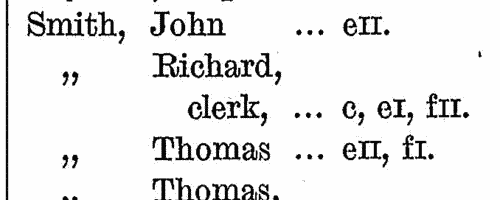
| Wandsworth Burials
(1733)
The ancient parish of Wandsworth in Surrey comprised the single township of Wandsworth, including the hamlets of Garratt, Half Farthing and Summers Town. It lay in the archdeaconry of Surrey of the diocese of Winchester: unfortunately, few bishop's transcripts of Surrey parish registers survive earlier than 1800. Although the original parish registers of Wandsworth doubtless commenced in 1538, the volume(s) before 1603 had been lost by the 19th century. In 1889 a careful transcript by John Traviss Squire of the first three surviving registers was printed, and we have now indexed it year by year. The early burial registers contain little detail - date of burial, and full name. For the burial of children, the father's name is also stated; for the burial of wives, the husband's. Such details as date or cause of death, age, address or occupation are almost never given. The burial registers are considerably more bulky than the baptism registers, because the burying ground was used by Dissenters, who formed a large part of the population. These include a French Protestant congregation that worshipped in a church (the registers of which do not survive) in a courtyard immediately opposite the parish church. The Quakers had a cemetery of their own. The 18th-century burial registers also include a surprising number of children sent out to Wandsworth from London to nurse. | Sample scan, click to enlarge
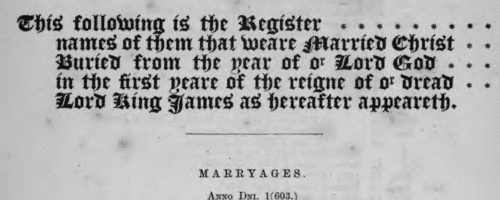
| Naval Lieutenants
(1741)
'A General List, or Catalogue, Of all the Offices and Officers Employ'd In the several Branches of his Majesty's Government Ecclesiastical, Civil, Military, &c. In South-Britain, or England' gives the names (and often the annual salaries) of the government functionaries, civil servants, churchmen and military, systematically arranged section by section. Section 47 lists lieutenants of his Majesty's Fleet, with the dates of their first commissions. | Sample scan, click to enlarge
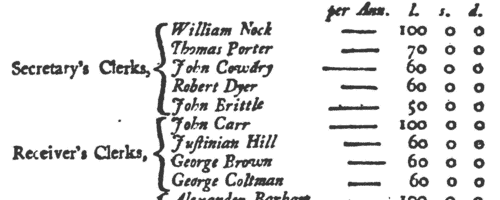
| Royal Navy Captains
(1746)
A general list of the captains of His Majesty's Fleet, with the dates of their first commissions as captains, from which they are allowed to take post. The list gives full name and exact date of seniority. | Sample scan, click to enlarge
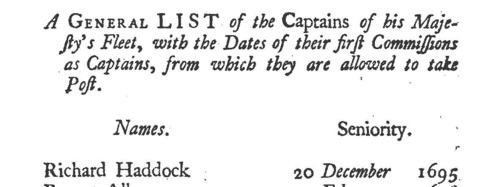
| Masters of Merchantmen
(1757)
The movements of British and foreign ships in Britain and abroad are recorded as Ship News in the London newspapers: these are the entries from January to June 1757. | Sample scan, click to enlarge
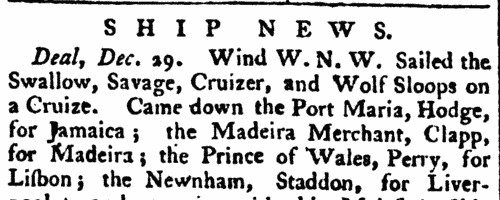
|
Research your ancestry, family history, genealogy and one-name study by direct access to original records and archives indexed by surname.
|











